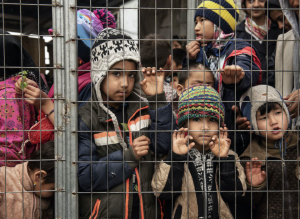Climate change, an undeniable and pressing global issue, has far-reaching implications that extend beyond environmental degradation. One of the most significant yet often overlooked consequences of climate change is its impact on global migration. As the planet warms, the frequency and intensity of extreme weather events increase, leading to a cascade of socio-economic challenges that
Climate change, an undeniable and pressing global issue, has far-reaching implications that extend beyond environmental degradation. One of the most significant yet often overlooked consequences of climate change is its impact on global migration. As the planet warms, the frequency and intensity of extreme weather events increase, leading to a cascade of socio-economic challenges that force people to migrate. This article delves into the multifaceted relationship between climate change and global migration, exploring the underlying causes, affected regions, and potential solutions.
Understanding Climate-Induced Migration

Image by : Yandex
Climate-induced migration refers to the movement of people due to sudden or gradual changes in their environment caused by climate change. These changes can manifest as natural disasters like hurricanes, floods, and wildfires, or as slow-onset events such as sea-level rise, desertification, and changing precipitation patterns. While migration has always been a part of human history, the current rate and scale of climate-induced migration are unprecedented.
Key Drivers of Climate-Induced Migration
- Extreme Weather Events: Hurricanes, typhoons, and floods displace millions of people annually. For instance, Hurricane Maria in 2017 led to a mass exodus from Puerto Rico, with thousands relocating to the mainland United States. Similarly, the 2010 floods in Pakistan displaced over 20 million people, highlighting the immediate and devastating impact of extreme weather events.
- Sea-Level Rise: Coastal communities are particularly vulnerable to rising sea levels. The Intergovernmental Panel on Climate Change (IPCC) predicts that sea levels could rise by up to 1 meter by the end of the century, threatening the existence of low-lying islands and coastal cities. Countries like Bangladesh, the Maldives, and parts of Southeast Asia are already experiencing the adverse effects, with communities being forced to relocate inland.
- Desertification and Drought: Arid and semi-arid regions are increasingly experiencing prolonged droughts, leading to the loss of arable land and water scarcity. In Sub-Saharan Africa, desertification is a significant driver of migration, as people move in search of better living conditions and livelihoods. The Sahel region, in particular, has seen a surge in migration due to the encroaching desert.
- Agricultural Disruption: Climate change affects crop yields and livestock productivity, disrupting food security. Farmers and herders facing reduced agricultural output are often compelled to migrate to urban areas or other countries. This phenomenon is evident in Central America, where changing weather patterns have led to crop failures, prompting many to seek refuge in the United States.
Regions Most Affected by Climate-Induced Migration
- South Asia: Home to densely populated countries like India, Bangladesh, and Pakistan, South Asia faces multiple climate-related challenges. Rising sea levels, intense heatwaves, and unpredictable monsoons contribute to large-scale displacement. Bangladesh, with its vast deltaic region, is particularly susceptible to sea-level rise and cyclones, displacing millions annually.
- Sub-Saharan Africa: This region is highly vulnerable to climate change due to its reliance on rain-fed agriculture and limited adaptive capacity. Countries like Nigeria, Sudan, and Ethiopia are experiencing increased desertification and water scarcity, driving rural populations to urban centers or across borders.
- Small Island Developing States (SIDS): SIDS like the Maldives, Tuvalu, and Kiribati face existential threats from rising sea levels. These islands have limited land and resources, making relocation within the country challenging. As a result, many inhabitants are forced to migrate internationally.
- Central America: The Northern Triangle countries of Honduras, Guatemala, and El Salvador are grappling with prolonged droughts and erratic weather patterns. These conditions exacerbate food insecurity and poverty, pushing many to migrate northward to the United States.
Socio-Economic Implications
Climate-induced migration has profound socio-economic implications for both origin and destination regions. In origin areas, the loss of population can lead to labor shortages, reduced agricultural output, and economic decline. Conversely, destination regions may experience increased pressure on infrastructure, housing, and social services. The influx of migrants can also lead to social tensions and competition for resources, potentially destabilizing communities.
Moreover, climate-induced migration often exacerbates existing vulnerabilities. Migrants may face legal and social challenges, including lack of legal status, discrimination, and limited access to healthcare and education. Women, children, and marginalized groups are particularly at risk, as they often have fewer resources and opportunities to adapt to new environments.
Policy Responses and Solutions

Image by : Yandex
Addressing the complex issue of climate-induced migration requires comprehensive and multi-faceted policy responses. Key strategies include:
- Adaptation and Resilience Building: Investing in climate-resilient infrastructure, sustainable agriculture, and early warning systems can help communities better withstand climate impacts. For example, constructing flood defenses and promoting drought-resistant crops can reduce the need for migration.
- Legal and Institutional Frameworks: Developing legal frameworks to recognize and protect climate migrants is crucial. The Global Compact for Safe, Orderly, and Regular Migration, adopted by the United Nations in 2018, is a step in this direction. However, more needs to be done to ensure that climate migrants have access to legal protection and support.
- International Cooperation: Climate change is a global issue that requires international collaboration. Countries must work together to address the root causes of climate change and support vulnerable regions. This includes providing financial and technical assistance to developing countries to enhance their adaptive capacity.
- Community-Based Approaches: Empowering local communities to participate in decision-making processes and develop context-specific solutions is essential. Community-based adaptation projects, such as participatory watershed management and community-led relocation plans, can enhance resilience and reduce displacement.
- Migration as Adaptation: Recognizing migration as a legitimate adaptation strategy can help frame policies that support safe and planned relocation. Facilitating voluntary migration through legal channels and providing support for migrants can reduce the adverse impacts of forced displacement.
Conclusion
The impact of climate change on global migration is a pressing and complex challenge that requires immediate and coordinated action. As climate change continues to reshape our world, understanding and addressing the drivers and consequences of climate-induced migration is essential for building a sustainable and equitable future. By investing in resilience, developing supportive legal frameworks, and fostering international cooperation, we can mitigate the impacts of climate change and ensure that those affected have the resources and opportunities to thrive.
















